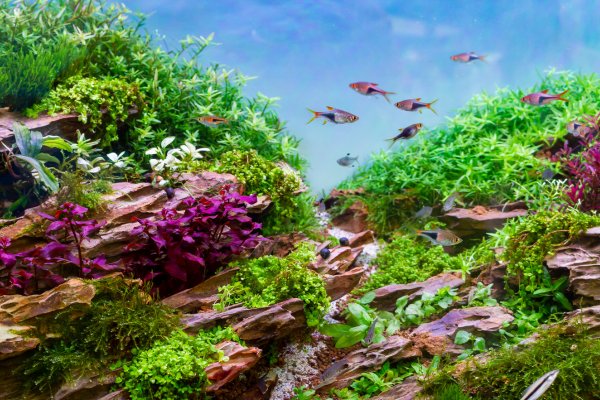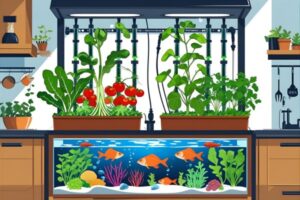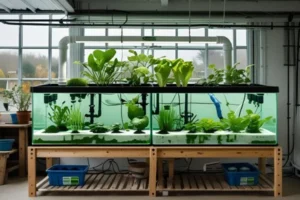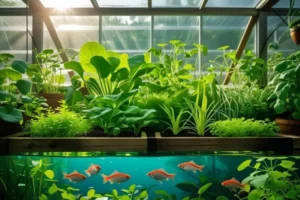Did you know that urban aquaponics systems have grown by over 300% in the last five years, with small-scale desktop systems leading this remarkable trend? As more people discover the magic of growing fresh food indoors, aquaponics aquariums are becoming the perfect solution for space-conscious gardeners and sustainability enthusiasts.
The challenge many face today is simple yet frustrating: limited space, expensive groceries, and the desire to grow their own food. Traditional gardening requires yards, soil, and favorable weather conditions that most urban dwellers simply don’t have. Hydroponic systems can be complex and expensive, while traditional aquariums offer beauty but no practical food production.
Enter the aquaponics aquarium – a revolutionary approach that transforms any standard fish tank into a productive, self-sustaining ecosystem. This complete guide will show you exactly how to convert your existing aquarium or build a new aquaponics system that fits perfectly on your kitchen counter, office desk, or apartment balcony.
You’ll discover how to grow fresh herbs, leafy greens, and even small vegetables while maintaining beautiful, healthy fish – all in the same compact system. By the end of this article, you’ll have everything needed to start your own desktop food revolution.
What is an Aquaponics Aquarium? Understanding the Basics
An aquaponics aquarium is a closed-loop ecosystem that combines fish farming (aquaculture) with soilless plant growing (hydroponics) in a single, compact unit typically ranging from 10 to 50 gallons (37.8 to 189.2 liters). Unlike traditional aquariums that focus solely on fish display, aquaponics aquariums create a symbiotic relationship where fish waste provides nutrients for plants, while plants naturally filter and clean the water for fish.
The magic happens through the nitrogen cycle. Fish produce ammonia through their waste and respiration. Beneficial bacteria (Nitrosomonas and Nitrobacter) convert this toxic ammonia first into nitrites, then into nitrates – the primary nutrient plants need to thrive. Plants absorb these nitrates through their roots, effectively removing them from the water and returning clean, oxygenated water back to the fish compartment.
Traditional aquariums require frequent water changes (typically 25% weekly), expensive filtration systems, and constant chemical balancing – costs that can reach 200 to 400 USD annually for a 20-gallon (75.7-liter) tank. Aquaponics aquariums eliminate 90% of water changes, reduce filtration needs, and provide fresh food worth 300 to 600 USD per year in herbs and vegetables.
The key differences extend beyond economics. Standard aquariums are consumption-based systems requiring constant inputs (food, chemicals, electricity for filtration). Aquaponics aquariums are production-based systems that generate outputs (food, cleaner environment, educational value) while requiring minimal external inputs.
Small-scale systems offer unique advantages: faster plant growth rates (30% to 50% faster than soil), year-round growing seasons, zero pesticides, and the ability to grow both protein (fish) and vegetables simultaneously. These desktop ecosystems typically measure 24 to 36 inches (60.9 to 91.4 cm) in length, making them perfect for apartments, offices, or classroom demonstrations.
Best Aquarium Sizes and Types for Aquaponics Systems
Choosing the right aquarium size is crucial for aquaponics success, with the sweet spot typically falling between 20 to 40 gallons (75.7 to 151.4 liters) for beginners. Smaller tanks under 10 gallons (37.8 liters) lack biological stability, while systems over 50 gallons (189.2 liters) become complex and expensive for desktop applications.
Ideal Size Ranges by Experience Level:
Beginner Systems: 20 to 29 gallons (75.7 to 109.7 liters) provide excellent stability with manageable complexity. These systems support 3 to 5 small fish and 8 to 12 plant sites, producing approximately 2 to 3 pounds (0.9 to 1.4 kg) of fresh herbs monthly.
Intermediate Systems: 30 to 40 gallons (113.5 to 151.4 liters) offer expanded growing capacity while maintaining desktop compatibility. Expect yields of 4 to 6 pounds (1.8 to 2.7 kg) of mixed vegetables and herbs monthly.
Advanced Desktop Systems: 40 to 50 gallons (151.4 to 189.2 liters) maximize production potential, supporting 6 to 10 fish and 15 to 20 plant sites.
Material Considerations:
Glass aquariums remain the gold standard for aquaponics applications. They resist scratching, maintain clarity, and handle pH fluctuations better than alternatives. Expect to invest 80 to 200 USD for quality glass tanks.
Acrylic aquariums weigh 50% less than glass and offer superior insulation properties, reducing heating costs by 15% to 20%. However, they scratch easily and typically cost 20% to 30% more than glass equivalents.
Tank Shape Optimization:
Rectangular tanks provide maximum surface area for gas exchange and plant placement. The ideal dimensions follow a 4:2:1 ratio (length:width:height), such as 36 x 18 x 12 inches (91.4 x 45.7 x 30.5 cm).
Bow-front designs offer aesthetic appeal but reduce usable growing space by approximately 15%. These work well for decorative applications where visual impact matters more than maximum production.
Avoid tall, narrow tanks that restrict surface area and create poor water circulation patterns essential for healthy aquaponics function.
Essential Equipment and Components for Your Aquaponics Aquarium
Building a successful aquaponics aquarium requires specific equipment designed to maintain water circulation, biological filtration, and optimal growing conditions. Here’s your complete shopping list with realistic pricing for a 20 to 30-gallon (75.7 to 113.5-liter) system.
Water Circulation System:
Submersible Water Pump: The heart of your system requires 150 to 200 gallons per hour (567.8 to 757.0 liters per hour) flow rate. Quality pumps like the Aqueon QuietFlow cost 25 to 45 USD and consume only 6 to 8 watts of electricity.
Flexible Tubing: Use 0.5-inch (1.27 cm) diameter vinyl tubing for main circulation lines. Expect 10to15 USD for 10 feet (3.0 meters) of food-grade tubing.
Growing Components:
Growing Medium: Expanded clay pebbles (hydroton) or gravel provide biological filtration and plant support. A 25-pound (11.3 kg) bag costs 20 to 30 USD and serves multiple systems.
Net Pots: 3-inch (7.6 cm) diameter pots work perfectly for most herbs and leafy greens. Purchase 20 pots for 15 to 25 USD.
Lighting System:
LED Grow Lights: Full-spectrum LEDs consuming 24 to 36 watts provide optimal plant growth. Quality fixtures cost 40 to 80 USD and last 50,000+ hours.
Timer System: Automate lighting cycles with digital timers costing 15 to 25 USD. Program 14 to 16 hours daily for leafy greens.
Monitoring Equipment:
API Master Test Kit: Essential for tracking ammonia, nitrite, nitrate, and pH levels. This 25 to 35 USD investment lasts 6 to 8 months with regular testing.
Digital Thermometer: Maintain water temperature between 68°F to 78°F (20°C to 25.6°C). Quality units cost 10 to 20 USD.
Total System Cost: Complete starter systems range from 200 to 400 USD, depending on tank size and component quality. Monthly operating costs average 8 to 15 USD for electricity and fish food.
Step-by-Step Setup Guide: Building Your Aquaponics Aquarium
Transform your standard aquarium into a thriving aquaponics system with this detailed setup process. Allow 2 to 3 weeks for complete establishment, with most work completed in the first weekend.
Phase 1: Aquarium Preparation (Day 1)
Start with a thoroughly cleaned 20 to 40-gallon (75.7 to 151.4-liter) tank. Rinse all components with dechlorinated water only – never use soap or chemicals. Position your tank away from direct sunlight to prevent algae blooms, ensuring access to electrical outlets within 6 feet (1.8 meters).
Install your growing bed above the main tank using a sturdy shelf or purpose-built stand. The growing container should hold 3 to 5 gallons (11.3 to 18.9 liters) and sit 8 to 12 inches (20.3 to 30.5 cm) above the water surface for proper drainage.
Phase 2: Circulation System Installation (Day 1-2)
Mount your submersible pump at the tank’s bottom, connecting it to 0.5-inch (1.27 cm) tubing that reaches your growing bed. Install a simple ball valve to control flow rate at 150 to 200 gallons per hour (567.8 to 757.0 liters per hour).
Create drainage by drilling a 0.75-inch (1.9 cm) hole in your growing bed, installing a bulkhead fitting connected to return tubing. Test circulation before adding any biological components.
Phase 3: System Cycling (Days 3-21)
Fill your system with dechlorinated water heated to 75°F to 78°F (23.9°C to 25.6°C). Add beneficial bacteria starter culture and a small amount of fish food daily to establish the nitrogen cycle.
Monitor water parameters every 2 to 3 days using your test kit. Expect ammonia spikes during week 1, nitrite peaks during week 2, and stable nitrate levels by week 3.
Phase 4: Stocking (Days 22-28)
Introduce 2 to 4 small fish gradually, monitoring closely for stress signs. Add 6 to 10 seedlings in net pots filled with growing medium once nitrate levels reach 20 to 40 ppm (parts per million).
Best Fish Species for Small Aquaponics Systems
Selecting appropriate fish species determines your aquaponics aquarium’s success, productivity, and maintenance requirements. Small-scale systems between 20 to 40 gallons (75.7 to 151.4 liters) require hardy, compact fish that produce adequate waste for plant nutrition without overwhelming biological filtration capacity.
Tropical Species for Heated Systems:
Goldfish remain the ultimate beginner choice for aquaponics aquariums. These resilient fish tolerate temperature fluctuations between 65°F to 78°F (18.3°C to 25.6°C), produce excellent waste-to-plant-nutrition ratios, and cost only 2 to 5 USD each. Stock 1 goldfish per 10 gallons (37.8 liters) for optimal balance.
White Cloud Mountain Minnows excel in smaller systems, requiring minimal space while producing consistent waste output. These peaceful fish thrive in 64°F to 72°F (17.8°C to 22.2°C) water and cost 3 to 6 USD per fish. Maintain groups of 6 to 8 fish in 20-gallon (75.7-liter) systems.
Zebra Danios offer active behavior and exceptional hardiness. They tolerate pH swings between 6.0 to 8.0 and temperatures from 64°F to 75°F (17.8°C to 23.9°C). Purchase groups of 5 to 7 fish for 15 to 25 USD total.
Cold-Water Alternatives:
Mosquito Fish (Gambusia) provide natural pest control while thriving in unheated systems. These prolific breeders adapt to temperatures between 50°F to 85°F (10.0°C to 29.4°C) and often cost under $1 USD each.
Population Density Guidelines:
Maintain conservative stocking ratios of 1 inch (2.5 cm) of fish length per 2 gallons (7.6 liters) of water volume. A 30-gallon (113.5-liter) system supports approximately 6 to 8 small fish measuring 2 to 3 inches (5.1 to 7.6 cm) each.
Monitor ammonia levels closely during the first month. Healthy fish should consume food completely within 2 to 3 minutes, with excess feeding being the primary cause of system crashes in beginner setups.
Ideal Plants for Aquaponics Aquariums
Plant selection significantly impacts your aquaponics aquarium’s productivity and visual appeal. Small-scale systems excel with compact, fast-growing plants that thrive in nutrient-rich water while maintaining reasonable space requirements for desktop applications.
Beginner-Friendly Starter Plants:
Lettuce varieties represent the perfect introduction to aquaponics gardening. Buttercrunch, Red Sails, and Boston varieties mature in 28 to 35 days, requiring minimal space while producing impressive yields. Expect 4 to 6 ounces (113 to 170 grams) per plant with seed costs under $0.50 USD per head.
Basil offers exceptional value and rapid growth in aquaponics systems. Sweet Genovese and Thai basil varieties reach harvestable size in 21 to 28 days, continuing production for 3 to 4 months with regular pruning. Fresh basil commands 3 to 5 USD per ounce (28 grams) at grocery stores.
Spinach thrives in cooler conditions between 60°F to 70°F (15.6°C to 21.1°C), making it ideal for unheated systems. Baby spinach reaches market size in 25 to 30 days, producing 2 to 3 ounces (57 to 85 grams) per plant.
Fast-Growing Production Plants:
Swiss Chard provides continuous harvests for 4 to 6 months from single plantings. This colorful plant tolerates varying nutrient levels while producing 8 to 12 ounces (227 to 340 grams) of leaves monthly.
Green Onions (Scallions) regenerate quickly from root cuttings, providing fresh harvests every 2 to 3 weeks. Purchase organic green onions for 2 to 3 USD and propagate indefinitely.
Cilantro and Parsley offer year-round herb production with 20 to 25-day maturity periods. These compact plants fit easily in 3-inch (7.6 cm) net pots while commanding premium prices of 2 to 4 USD per ounce (28 grams).
Space Optimization Tips:
Maintain 4 to 6-inch (10.2 to 15.2 cm) spacing between plants for optimal light penetration. Rotate plantings every 2 to 3 weeks to ensure continuous harvests throughout the year.
Daily and Weekly Maintenance for Aquaponics Aquariums
Consistent maintenance routines ensure long-term success and prevent costly system failures in your aquaponics aquarium. Establishing proper daily and weekly schedules requires only 10 to 15 minutes daily and 30 to 45 minutes weekly, while dramatically improving system stability and productivity.
Daily Maintenance Tasks (5 to 10 minutes):
Fish Health Inspection involves observing feeding behavior and swimming patterns during morning feeding sessions. Healthy fish should consume food eagerly within 2 to 3 minutes, with any leftover food removed immediately to prevent ammonia spikes.
Water Level Monitoring checks for evaporation losses, typically 0.5 to 1.0 inches (1.3 to 2.5 cm) weekly in heated systems. Top off with dechlorinated water maintained at system temperature to prevent thermal shock.
Plant Growth Assessment identifies yellowing leaves, pest issues, or nutrient deficiencies before they spread. Remove dead or diseased plant material immediately, harvesting mature portions to encourage continued growth.
Equipment Function Check ensures pumps operate quietly and water circulation maintains proper flow rates of 150 to 200 gallons per hour (567.8 to 757.0 liters per hour). Clean pump intakes if flow appears reduced.
Weekly Maintenance Routines (30 to 45 minutes):
Comprehensive Water Testing using quality test kits checks pH, ammonia, nitrite, and nitrate levels. Record results in a maintenance log to track trends over time, enabling proactive adjustments.
Growing Medium Cleaning involves gently rinsing clay pebbles or gravel to remove accumulated debris. Clean approximately 25% of growing media weekly to maintain optimal bacterial colonization without disrupting biological filtration.
Root System Inspection checks for healthy white roots versus brown, mushy, or foul-smelling roots indicating disease. Trim damaged roots with sterilized scissors and adjust plant spacing if overcrowding occurs.
Deep Equipment Maintenance includes cleaning pump impellers, checking tube connections for leaks, and inspecting electrical connections for corrosion. Replace worn components immediately to prevent system failures.
Harvest and Replanting maintains continuous production by harvesting mature plants and starting new seedlings every 2 to 3 weeks for consistent yields.
Troubleshooting Common Aquaponics Aquarium Problems
Even well-maintained aquaponics aquariums encounter occasional challenges requiring swift identification and correction. Understanding common problems and their solutions prevents minor issues from becoming system-threatening crises, protecting your investment and ensuring continuous production.
Ammonia Spikes (Most Critical Issue):
Symptoms: Fish gasping at surface, lethargy, cloudy water, ammonia readings above 0.5 ppm Immediate Actions: Stop feeding for 24 to 48 hours, increase aeration, perform 25% water changes daily until levels drop below 0.25 ppm Prevention: Avoid overfeeding, maintain adequate biological filtration, test water every 2 to 3 days during first month
Plant Yellowing and Nutrient Deficiencies:
Iron Deficiency appears as yellowing between leaf veins while maintaining green veins. Add chelated iron supplement at 1 to 2 ppm weekly, costing 15 t o25 USD for 6-month supply.
Potassium Deficiency shows brown leaf edges and weak stems. Supplement with potassium sulfate at 10 to 20 ppm monthly, available for 10 to 20 USD per pound (454 grams).
Nitrogen Deficiency causes overall yellowing from bottom leaves upward, indicating insufficient fish waste or excessive plant density.
Pump and Circulation Failures:
Reduced Flow: Clean pump intake screen and impeller housing. Replace impellers every 12 to 18 months, costing 8 to 15 USD for quality pumps.
Complete Failure: Backup pumps (25 to 45 USD) prevent total system collapse during equipment failures. Maintain spare pumps for systems worth over $200 USD.
pH Fluctuations:
Rapid pH Swings stress fish and disrupt nutrient availability. Buffer systems using crushed coral or limestone chips provide natural pH stability for 5 to 10 USD per 5-pound (2.3 kg) bag.
Algae Overgrowth:
Green Water indicates excess nutrients and light exposure. Reduce feeding by 25%, limit lighting to 12 to 14 hours daily, and increase plant density to compete for nutrients.
Emergency Response Kit:
Maintain emergency supplies including backup pump, water conditioner, pH adjustment solutions, and beneficial bacteria cultures. Total cost: 75 to 125 USD for comprehensive emergency preparedness.
Conclusion
Your aquaponics aquarium represents more than just a sustainable growing system – it’s a gateway to food independence, environmental stewardship, and year-round fresh produce production. Throughout this comprehensive guide, we’ve explored every aspect from initial setup requiring 150 to 400 USD investment through daily maintenance routines taking just 10 to 15 minutes.
The systems we’ve discussed produce impressive results: 6 to 12 heads of lettuce monthly, fresh herbs worth 20 to 40 USD per month, and the satisfaction of growing chemical-free food in spaces as small as 4 to 6 square feet (0.37 to 0.56 square meters). Your 20 to 40-gallon (75.7 to 151.4-liter) system will mature within 3 to 4 weeks, providing decades of reliable production with proper care.
Remember that success comes through consistent monitoring, gradual learning, and patience during the initial cycling period. Start with hardy fish like goldfish and simple plants like lettuce before advancing to more challenging species. Your first harvest in 28 to 35 days will validate every effort invested in setup and maintenance.
The aquaponics community continues growing as more people discover these sustainable systems. Join online forums, connect with local practitioners, and share your experiences to accelerate learning and problem-solving.
Ready to start your aquaponics journey? Begin with our recommended starter kit components and transform your space into a productive, sustainable food source today! Share your setup photos and questions in the comments below – we’d love to see your aquaponics aquarium come to life!
Frequently Asked Questions (FAQ)
How much does it cost to start an aquaponics aquarium?
Initial setup costs range from 150 to 400 USD for complete beginner systems. Basic 20-gallon (75.7-liter) setups cost 150 to 250 USD, while advanced 40-gallon (151.4-liter) systems with automation reach 350 to 400 USD. Monthly operating costs include fish food (5 to 10 USD), electricity (8 to 15 USD), and occasional plant seeds (3 to 8 USD).
How long before I can harvest my first plants?
Fast-growing leafy greens like lettuce and spinach reach harvestable size in 28 to 35 days after planting. Herbs like basil mature in 21 to 28 days, while cilantro and green onions provide harvests in just 14 to 21 days. Your system needs 3 to 4 weeks to establish proper bacterial colonies before supporting optimal plant growth.
What’s the minimum space required for an aquaponics aquarium?
Desktop systems require as little as 4 to 6 square feet (0.37 to 0.56 square meters) of floor space. A 20-gallon (75.7-liter) system measures approximately 24 x 12 x 16 inches (61.0 x 30.5 x 40.6 cm), fitting comfortably on sturdy tables or dedicated stands. Vertical growing towers can triple production in the same footprint.
Do aquaponics aquariums smell or attract pests?
Properly maintained systems produce no unpleasant odors and actually improve indoor air quality through plant photosynthesis. Covered fish tanks prevent mosquito breeding, while beneficial bacteria eliminate waste odors. Poor maintenance or overfeeding can cause temporary ammonia smells, easily corrected through proper feeding schedules and water management.
Can children safely operate aquaponics aquariums?
Yes! These systems provide excellent educational opportunities for children aged 8 and older with adult supervision. Simple maintenance tasks like feeding fish, checking water levels, and harvesting plants teach responsibility while demonstrating natural cycles. All electrical components should remain adult-supervised, and children should wash hands after handling fish or water.
How much electricity do aquaponics aquariums consume?
Energy consumption ranges from 50 to 150 watts continuously, similar to running 2 to 3 LED light bulbs. Monthly electricity costs typically range from 8 to 15 USD depending on local rates. LED grow lights consume 24 to 50 watts, water pumps use 15 to 25 watts, and heaters (if needed) add 25 to 50 watts during operation.



